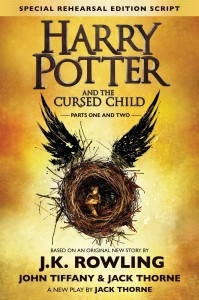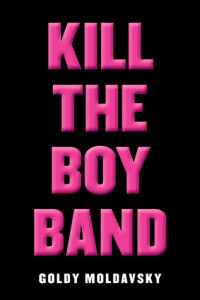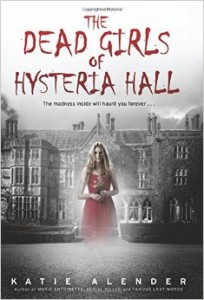What We’re Reading: Harry Potter and the Cursed Child
 Harry Potter and the Cursed Child by J.K. Rowling, John Tiffany, and Jack Thorne (Scholastic Books, July 2016)
Harry Potter and the Cursed Child by J.K. Rowling, John Tiffany, and Jack Thorne (Scholastic Books, July 2016)
WARNING: HERE THERE BE SPOILERS.
Generation X? Generation Y? Nah, son, I’m part of Generation P—Generation HP to be exact. Like many twenty-somethings around the world, I grew up with the original Harry Potter books and movies, waiting up eagerly until midnight for each release, dressing up as my favorite characters, and writing bad fanfiction and publishing it on the internet. When they announced the released of a new Potter story, I had mixed feelings. On one hand, I was ecstatic to be returning to the world I know and love. On the other, it was a new medium (a play script instead of a book), and I wasn’t sure how much of it was written out of love and how much of it was written out of a desire to milk the Potter cash cow to the very last drop. But, of course, I pre-ordered it from Amazon, read it in three straight hours, and here we are.
The script opens exactly where the Potter books end, with Harry, Ron, and Hermione ushering their children onto Platform 9 3/4 for their first year at Hogwarts. It’s a nice gesture to the fans, showing us that even though almost a decade has passed since the last book, nothing has changed. It also functions to orient us firmly on the timeline, something that will become extremely important later on. As it turns out, the main plot device of Harry Potter and the Cursed Child is time travel.
Harry’s middle child, Albus, is plagued by the fear that he can never live up to his father’s massive legacy. Hoping to step out of the shadows and prove himself, he and his best friend (the one, the only Scorpius Malfoy) hatch a scheme to steal a Time-Turner and save Cedric Diggory’s life. With the help of Delphini Diggory (Cedric’s cousin), the pair go back in time three successive times to the Triwizard Tournament, attempting to stop Cedric from winning the third task and subsequently being murdered by Voldemort. But, as they find out, time-travel is a messy thing, and each interference creates an alternate reality.
It’s a lot to pack into one book. The staged version, broken up into Part I and Part II, runs a full five and a half hours. Even then, many of the scenes are extremely short (some lasting only one or two pages), and it often felt rushed and unfulfilled. Frequently, we the reader didn’t have time to settle in before we were whisked away to another time or place. Add in all of the constantly-changing timelines (hopping from past to present and back again often with little cue), and it was sometimes difficult to keep track of what exactly was going on. This could be a flaw of reading the play instead of watching it; as the staged version has been receiving some rave reviews, I imagine those of us who only read it are missing out on something magical (pun intended).
The majority of the story walked the line between magical camp and just plain ridiculousness. In one scene, for example, Albus and Scorpius decide they aren’t going to Hogwarts that year. They decide the best way to avoid school is to jump off the roof of the Hogwarts Express…. while it’s moving. This isn’t the most bizarre part of the scene, however. When on the roof, they are stopped by the Trolley Witch (known for giving out sweets to the students), and it turns out there’s more to the old woman than meets the eye.
TROLLEY WITCH: These hands have made over six million Pumpkin Pasties. I’ve gotten quite good at them. But what people haven’t noticed about my Pumpkin Pasties is how easily they transform into something else. . .
She picks up a Pumpkin Pasty. She throws it like a grenade. It explodes.
And you won’t believe what I can do with my Chocolate Frogs. Never—never—have I let anyone off this train before they reached their destination. Some have tried—Sirius Black and his cronies, Fred and George Weasley. ALL HAVE FAILED. BECAUSE THIS TRAIN—IT DOESN’T LIKE PEOPLE GETTING OFF IT. . .
The TROLLEY WITCH’s hands transfigure into very sharp spikes. She smiles.
So please retake your seats for the remainder of the journey.
During this scene, and many others throughout the book, I found myself wondering, “am I secretly reading fanfiction?” Don’t get me wrong—I love fanfiction, but there was something about The Cursed Child that was so fantastical, so absurd, that it was hard to accept that this latest installment was actually canon.
At the end of the book (I did warn for spoilers), we discover that Delphi, who had been helping Albus and Scorpius, is not in fact Cedric Diggory’s cousin, but the long-lost child of Lord Voldemort and Bellatrix Lestrange. It’s a twist that fans have been speculating about for years, but in The Cursed Child, it seemed too easy. It felt like a cop-out that, instead of creating a new villain for a new generation, we were handed a repackaged version of the original Big Bad.
If this had been any other book, in any other series, I doubt I would have made it past the first one hundred pages. But nostalgia, dear reader, is a funny thing. Despite all of its flaws, The Cursed Child kept me spellbound (no pun intended), racing through page after page. No matter how much it may have seemed like a caricature, I have to say that I loved it. Like many other Potterheads I know, I would read about Harry, Ron, and Hermione sitting on a couch and watching Netflix if it meant I could return to the world that I loved. Reading The Cursed Child felt like curling up into your favorite sweater, or taking a bite of your mom’s apple pie. It felt like going home.
What are your “cozy sweater books”? What books can you always count on to make your day?
What We’re Reading: Kill the Boy Band
 Kill the Boy Band by Goldy Moldavsky (Scholastic, February 2016)
Kill the Boy Band by Goldy Moldavsky (Scholastic, February 2016)
In honor of Women’s History Month, I chose a book that highlights one of the most easily dismissed and easily mocked subsets of women: the teenage girl.
“But you review YA!” you might be saying. “How can teenage girls be dismissed if they have a whole genre dedicated to them?”
That might be true. But if you look through criticisms of the genre, through the plethora of reviewers and publishers alike who deem YA frivolous or poorly-written, you’ll find that a lot of them have eerily misogynistic origins. From YA novels to boy bands to high school rom-coms, the list of things which are denigrated by our society solely because their fan base is made up of teenage girls goes on and on. It explains quite easily why so many girls—who turn into so many women—struggle with confidence and self-image. Why would you be proud of who you are when at every turn, you are mocked for being excited about something, for caring a little too much?
When I picked up Kill the Boy Band, I wasn’t quite sure which way it would go. With its clickbait-y title and bright pink letters, I wasn’t sure if it was going to be enforcing the stereotype that teenage girls are “crazy” and hormonal and dismissable, or if it was going to be a celebration, a dismantling of the sexist norms and a battlecry for girls liking things with unabashed enthusiasm.
Open the book, and you’re dropped right into the middle of the action. The narrator, a 15-year-old girl who never reveals her real name but instead uses a series of pseudonyms derived from 1980s John Hughes flicks, and her best friends, Erin, Apple, and Isabel, have camped out at a hotel in downtown Manhattan in hopes of catching a glimpse of their favorite boyband, The Ruperts. The Ruperts are a very thinly-veiled fictionalization of One Direction: four barely-teenaged boys, all named Rupert, who met on a United Kingdom vocal competition, were convinced to form a boyband, and now have an army of fangirls who call themselves Strepurs (Ruperts spelled backwards. And yes, if you’re wondering, the book does joke about the fact that Strepurs is pronounced “strippers”). Our narrator (we’ll call her Sloane for now, after Sloane Peterson, one of her many disguises) opens the door to her hotel room, only to find Rupert P. gagged and bound to a chair. The girls are forced to decide whether to follow through on this so-called accidental kidnapping or to let Rupert P. go, and deal with the repercussions. The book is a wild, ridiculous ride filled with macabre humor, conspiracy theories, and impossible situations. It’s the literary version of cotton candy—sickening sweet and nothing but fluff.
I wholeheartedly believe that every teenage girl on the planet goes through a “fangirl” stage. Maybe it’s not a boyband. Maybe it’s an actor, or a teacher, or an astrophysicist, or (in the case of this nerdy reviewer) a minor Harry Potter character. But I believe there comes a time in every teenage girl’s life when she falls head-over-heels in love with something bigger than herself. Fandom is something that Goldy Moldavsky nails completely on the head. Instead of gushing about it, I’ll just let Moldavsky’s narrator show you:
Other people may have seen fangirls as crazy teenage girls obsessed with a fad, but they couldn’t understand the small but important joy you can get from indulging in these fandoms. They didn’t get the friendships that formed, the community of people who shared in your same joy. Maybe it was obsession, but it was also happiness; an escape from the suckiness of everyday life. And when you find something that makes you happy and giddy and excited every day, us fangirls know a truth that everyone else seems to have forgotten: You hold onto that joy tenaciously, for as long as you can. Because it’s rare to get excited about anything these days. Ask your parents.
Yes, the book is humorous. Yes, it occasionally exaggerates and pokes fun at the fangirls. But it doesn’t feel like a condemnation. It feels like the gentle teasing of someone who has been on the inside.
Another aspect of this book that Moldavsky pulled off was the unreliable narration. Sloane is the ultimate teenager. She exaggerates. She gets overly excited about things. She plants just enough doubt in your mind to make it entirely feasible that she’s making up the whole thing. She’s unapologetically biased. Best of all, this effect is pulled off entirely naturally, never feeling forced or unnecessary.
I’ll be honest: for all that I enjoyed this book, it wasn’t perfect. It was a fun, lighthearted read, the kind that you need once in a while to escape from the “grown-up world.” But many, if not all, of the characters were one-dimensional. Plot points were introduced and then discarded with no resolution. At one point, a character reveals that she was almost sexually assaulted, and the incident is swept under the rug; later, the character is victim-blamed and made out to be unstable. The female friendships that I had hoped would be the foundation of this novel fell apart as Sloane decided she was better than her shallow, foolish comrades. There were many “one step forward, two steps back” moments for feminism in this book. It was a decent book, at the end of the day, but it was also entirely forgettable.
What other representations of fangirls/fandoms have you found? Are they positive portrayals?
What We’re Reading: The Dead Girls of Hysteria Hall
 The Dead Girls of Hysteria Hall by Katie Alender (Point, September 2015)
The Dead Girls of Hysteria Hall by Katie Alender (Point, September 2015)
Is that font “Chiller”? Does the title sound like last summer’s box-office flop? Is this cover in general just really, really bad? The answer to all of these questions is a resounding YEP. The book that I read for this month’s What We’re Reading is a testimony to the adage, “Don’t judge a book by its cover.”
Guys, this book was really, really good.
Katie Alender sets the stage for The Dead Girls of Hysteria Hall with all the hallmarks of a cheesy haunted house flick. A sulky teenage girl (Delia, our protagonist) is dragged on a summer trip to a creepy old mansion (nicknamed “Hysteria Hall”) left to her by her dead great-aunt (a recluse who unexpectedly killed herself mere weeks prior).
Oh, and did I mention that the creepy old mansion used to be an asylum?
By the time I’m twenty pages in, I’m pretty confident that I’ve got this book figured out. Some ghosts will show up, there’ll be some creepy messages left in what is probably blood, and at least two members of the family will die. I’ve settled in for your standard haunted house book, and while I’m enjoying it already, I’m not really expecting anything game-changing. Oh, was I ever wrong.
[Warning: here there be spoilers.]
Fifty pages in, Delia, our plucky protagonist… dies. Locked in her bedroom, Delia finds herself surrounded by an ominous cloud of black smoke. Ten seconds later, her soul is staring down at her body, flung from the highest window and definitely not breathing. From here on out, the narrative is entirely inverted from expectations. Delia is no longer the haunted but the haunting. Her goal? Use her newfound ghostly powers (and her newfound ghost friends, Florence, Eliza, and Patience) to scare her sister and her mother out of the house, saving them from the same horrible fate.
The Dead Girls of Hysteria Hall is the young adult feminist horror romp you never knew you needed. The Bechdel Test is passed in the first few pages; the most important relationship established in the novel is that between Delia and her sister, Janie. While this novel isn’t making any great strides in terms of feminist theory (the most progressive its rhetoric gets regards the ridiculousness of the concept of “hysteria” and the time-honored tradition of calling women “crazy” when they get too dangerously independent), it’s revolutionary simply in its cast. There are only three male characters (as opposed to roughly ten unique, well-rounded, complex women) who make up fifteen percent of the book’s screen time, if I’m being generous. This book is about femininity, about mothers and daughters and sisters and friends, about being underestimated, about being weak and being okay.
Like most YA novels, there is still a romantic subplot for Delia. This comes in the form of Theo, a dapper gentleman ghost from the 1920s, but their romantic interlude occupies two chapters at most. Delia and Theo’s relationship is a luxuriously slow build that emphasizes the fact that this book isn’t about their love — it’s about Delia’s own growth.
Most of my enjoyment of this book came from two planes: the concept (and its girl-powered cast), and its surface-level thrills. While I genuinely enjoyed The Dead Girls of Hysteria Hall, I probably wouldn’t expect to find it on the Printz Award list any time soon. The prose wasn’t bad, but it didn’t leave me breathless either; a few days out from finishing it, and I can’t pick out any passages that really lingered with me. In addition, a handful of the plot points seemed either forced or rushed. Characters who were marked as evil were suddenly redeemed with little explanation.
Then again, why do all books have to be flawless and profound musings? I don’t believe in the term “guilty pleasure.” I think we can genuinely enjoy things that aren’t perfect without having to defend ourselves. Sometimes, I just want a fun, lighthearted feminist gore-fest that scares my pants off.
Katie Alender’s The Dead Girls of Hysteria Hall is exactly that.
What are your favorite spooky reads?






